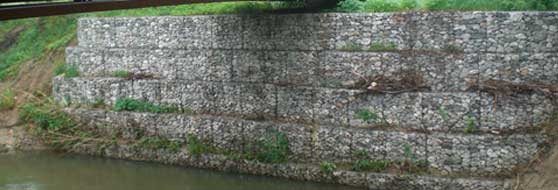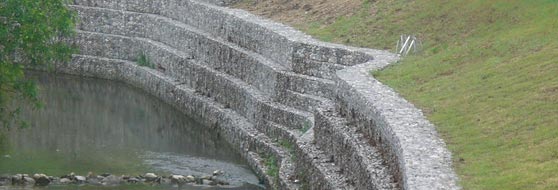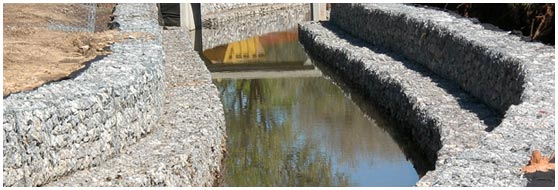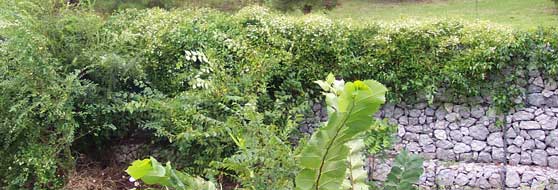Gabion Gravity Retaining Walls
Terra Aqua’s gabion gravity retaining wall systems are monolithic gravity mass structures and follow standard design methods for gravity retaining walls. The following information is provided by Terra Aqua as a design guide to assist Professional Engineers, Government Agencies, Land Developers, and Contractors in the proper design, specification, construction and inspection of gabion gravity retaining walls.
Design Considerations
Terra Aqua always recommends that the soil data utilized for gabion wall design be based on a Certified Geotechnical Soils Report of the site location. Terra Aqua can provide a complete gabion retaining wall stability analysis upon request.
Terra Aqua gabion walls are constructed with natural stone. As drainage occurs soil particles are deposited into the small voids of the natural stone fill within the wall allowing for pockets of vegetation to take root.
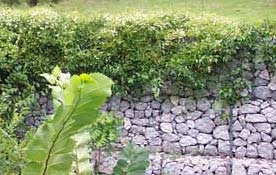
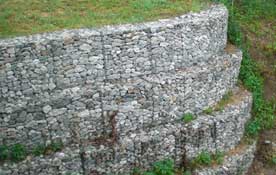
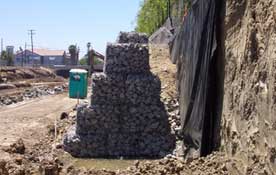
Pressure at the Base
The total pressure of the gabion wall must be less than the anticipated bearing capacity of the soil under the base of the wall. The contact pressure on a flexible gabion footing is not distributed in a planar fashion, but decreases from a maximum at the point of application of the resultant to lesser values at the edges of the footing. The pressure at the toe of a gabion wall is, therefore, generally less than for a rigid wall.
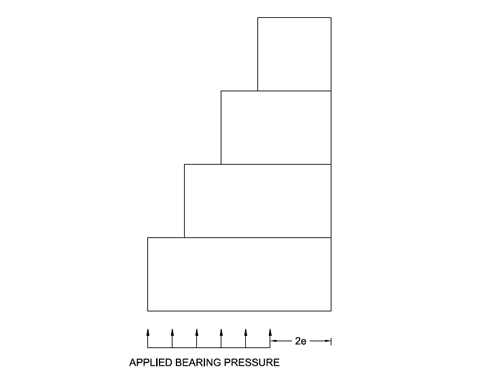
The calculations for the subgrade reaction in flexible foundation are awkward and involve errors associated with evaluating the coefficient of subgrade reaction. The error in assuming this is on the safe side, since the reaction is assumed to have a planar distribution, as in rigid walls.
Foundation Preparation
Terra Aqua gabion gravity retaining walls are typically placed directly on a graded soil foundation. To increase the bearing capacity, minimize differential settlement, and/or allow for additional drainage, a base layer of granular stone fill with consistent gradation ranging ½” – 11/2” may be placed and compacted to local standards 6” – 18” in depth as a founding course for wall placement.
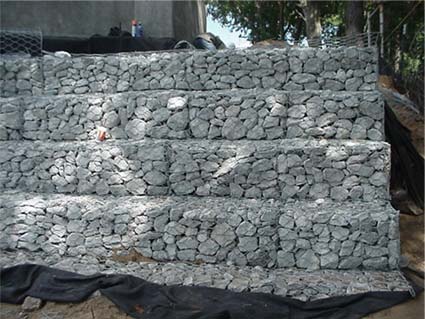
Foundation grade & Wall batter
It may be determined, through an investigation and stability analysis, that additional stability of the gabion wall may be required to achieve acceptable factors of safety for sliding. One option to pursue prior to enlarging the wall cross section for additional stability is to place wall on a 6 – 10 degree batter towards the retained slope. This will require the founding soils to graded and compacted to accommodate for the specified wall batter.
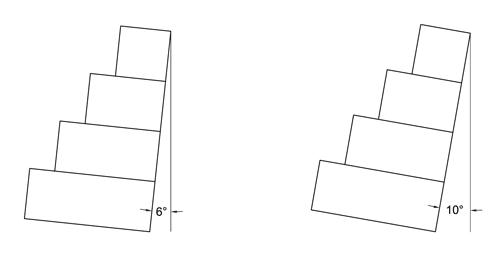
Foundation below grade
Terra Aqua gabion gravity retaining walls may be placed or keyed in below sub grade to prevent scour and wave action from undermining the toe of the structure. The rule of thumb for depth of placement below sub grade is approximately 2 times anticipated depth of scour.
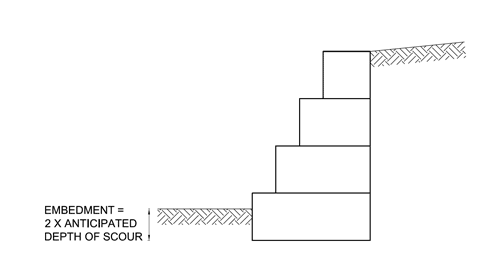
Scour Apron
A flexible double twisted mesh Terra Aqua gabion is designed to settle without fracture and adhere to the ground as scour occurs. Graded fill material ranging from 4"-8" for standard gabions and 3"-6" for reno mattresses will ensure uniform flexibility of the apron and will create a new state of equilibrium of the structure once settlement has occurred providing continued stability. Gabion aprons are commonly used to protect the toe of a retaining wall structure from scour that could cause undermining in channel works applications. It is recommended that the gabion apron be a minimum of 9"-12" in depth. The length of the gabion apron shall extend beyond the toe of the structure a minimum of 2 times the anticipated depth of scour. This will ensure that the gabion apron reaches just beyond the outer limit of the anticipated scour hole that may form.
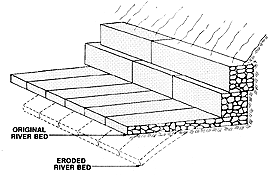
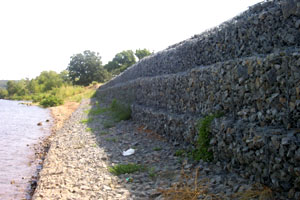
The gabion apron will require minimal excavation and grade work. Generally the apron is placed directly on the ground utilizing a geotextile filter fabric between the gabion apron soil interface to prevent and leaching of soils from underneath the apron. If the gabion apron is placed in relatively deep water, and efficient method of large scale placement is prefabricating the apron on a barge and then launching it into the water. The size of the gabion apron that can be placed by this method is limited only by the deck area of the barge. Gabions or reno mattresses may also be connected together filled and then placed into the water with a sling arrangement. This method is frequently used for building scour-resisting mats around bridge piers etc. Gabion aprons may be fabricated using Terra Aqua standard PVC gabion units or with Terra Aqua PVC reno mattresses.
Backfill & Compaction
Backfill Material-Gabion gravity retaining walls, in comparison with reinforced soil walls, allows for a wider range of soil types to be utilized as backfill material. This is due to the gabion gravity walls configuration, typically low wall heights, and porous facing. It is imperative to the overall long term performance of a gabion gravity retaining wall that the specified backfill material be properly placed and compacted. Poor compaction of backfill materials can lead to structural settlement, lateral wall movement, and result in insufficient shear strength to perform as designed. Specified backfill material shall be placed and compacted to minimum Standard Proctor 95% in lifts not to exceed 9” vertical and shall comply with local standards.
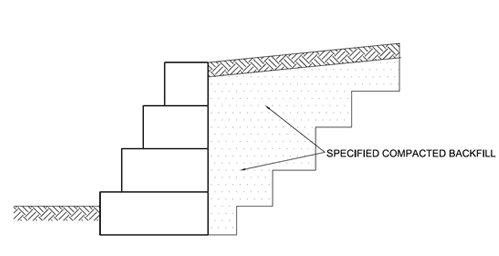
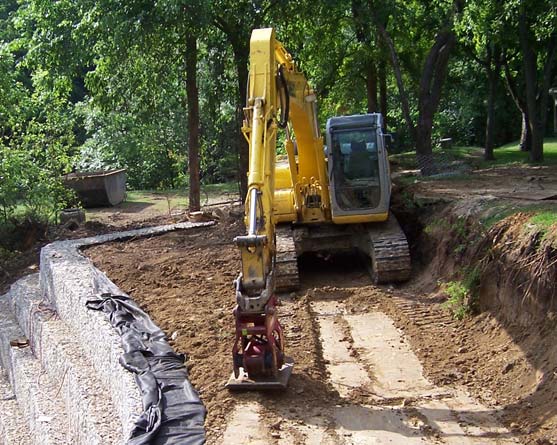
Soil Data
Recommendation Of use for backfill |
Soil Description |
Soil Classification |
Angle of Internal Friction |
Unit weight of Soil |
| Excellent | Stone, Gravel, Sand |
1 & 2 GP, GW, GM, GC, SW, SP | 30-36 | 100-135 pcf |
| Good | Clayey Sands, Silty Sands |
3 SM, SC |
28-32 | 110-130 pcf |
| Poor | Soft Clay, Soft Silts |
4 ML, CL, OL | 25-30 | 110-125 pcf |
| Bad | Stiff Clay |
5 CL, CH |
25-30 | 50-110 pcf |
For type 5 material H is reduced by 4 ft resultant Acts at a height of (H-4)/3 above base. Adapted from Terzaghi and Peck |
||||
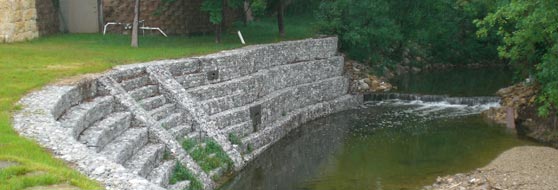
Filter Fabric
Geotextile filter fabric is a vital component of any gabion gravity retaining wall. The void ratio of the stone fill confined within the gabion baskets allows for free drainage of the retained soils and requires a filter fabric be placed between the wall and the specified backfill soil interface. The geotextile filter fabric will prevent loss of soil during drainage and drawdown. Gabion gravity retaining walls constructed without the placement of filter fabric will have a tendency to incur a loss of retained soils and grade elevation behind the gabion wall. The type of backfill soil specified will determine the type, and placement of the geotextile filter fabric. Call Terra Aqua for recommendations on filter fabric.
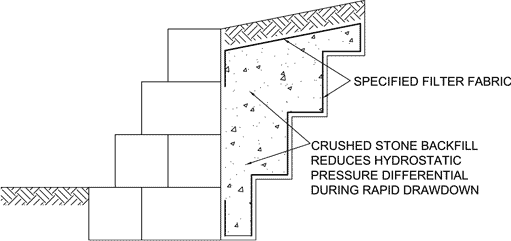
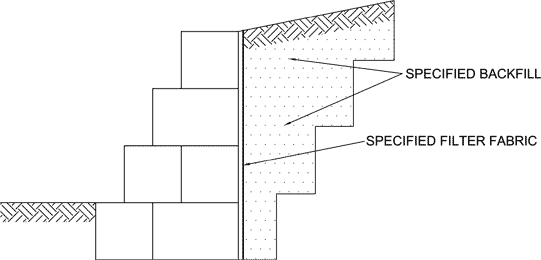
Layout
To provide the maximum resistance to soil forces, the gabion baskets shall be placed with the length dimension of the unit running from the back of the gabion wall to the front face of the gabion wall. This will result in the internal diaphragms being placed perpendicular to the wall face and parallel to soil thrust. When gabion units shall be placed with the length dimension of the gabion unit running parallel with the length dimension of the wall the vertical seams shall be offset.
Compression Loads
For gabion gravity retaining walls that are 15’ – 30’ in height the gabion basket foundation and bottom courses shall be placed in 1.5’ vertical lifts to better absorb the compression and shear stresses. Terra Aqua’s double twisted mesh gabions shall withstand compression loads of 60,000 – 80,000 pounds per square foot. The shear modulus of elasticity shall vary between 5,000 – 8,000 pounds per square foot and is relevant to deformation.
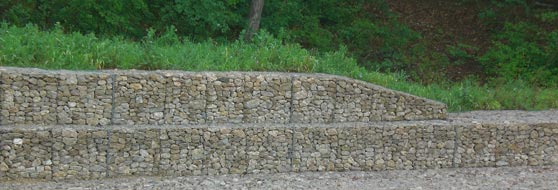
Gabion Wall Face Configuration
Terra Aqua gabion retaining walls can be designed and configured with a stepped front face or a smooth front face. When utilizing a gabion wall with a smooth front face, the gabion wall shall always be placed on a 6-10 degree batter and is not recommended for wall heights above 18’. Gabion walls with a stepped front face shall have a minimum 1’-1.5’ horizontal set back for each 3’ vertical lift.
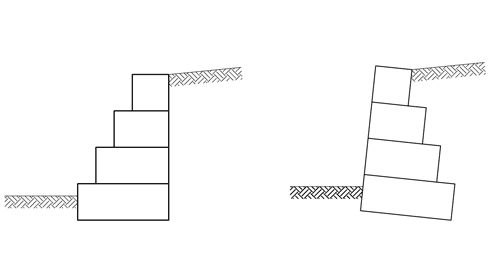
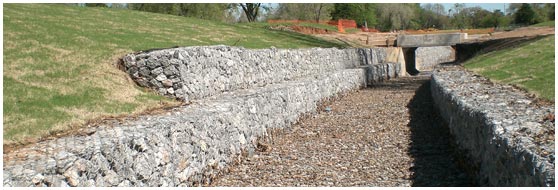
Gabion Wall Height
Terra Aqua gabion gravity retaining walls can be designed and constructed up to approximately 30’, however due to the configuration of gabion gravity retaining walls their best suited for wall heights of 18’ or less. For wall heights of 18’- 36’ see the Stable Slope Section of this web site.
Gabion Wall base width relative to wall height
base width of a gabion gravity retaining wall is related to height of wall so as the wall height increases the base of the wall becomes wider to ensure structural stability. Terra Aqua has provided the diagram below to illustrate a starting point for design analysis to determine the base width relative to wall height. Terra Aqua recommends a conservative value of base width = 2/3 wall height. The stability analysis may determine that the gabion gravity retaining wall base width be less than or greater than ½ - 2/3 wall height.
GABION GRAVITY WALL SIZES & DIMENSIONS
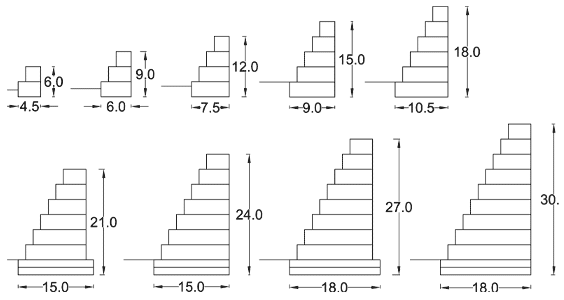
GABION STONE FILL
| Galvanized/Galfan Gabions 8x10cm | 4 inches – 8 inches D50 6” |
| PVC Coated Gabions 8x10cm | 4 inches – 8 inches D50 6” |
Acceptable stone for gabion construction shall be hard, durable, equally graded, angular in shape, and shall not be less than 4” in any given dimension and no larger than 8” in any given dimension. The specific gravity required for the stone fill shall be determined by the design and specified by the design engineer. Specific gravity for stone fill shall be no less than 2.5.
| TYPE OF ROCK |
LBS/CUBIC FT |
| BASALT | 180 |
| GRANITE | 160 |
| LIMESTONE | 138 |
| SANDSTONE | 140 |
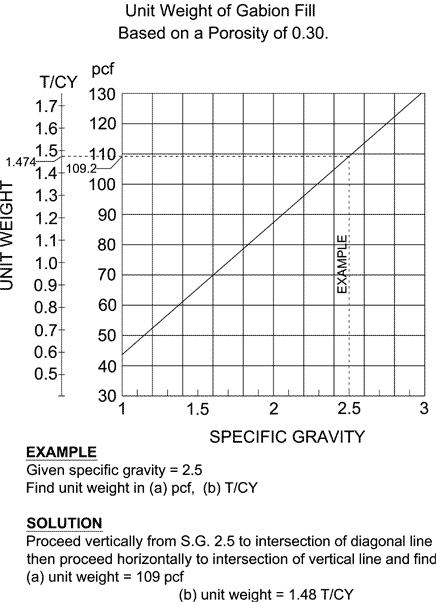
SPECIFIC GRAVITY OF MATERIALS
| BASALT | 3.0 |
| BRICK | 2.0 |
| BROKEN CONCRETE | 2.4 |
| GRANITIE | 2.7 |
| LIMESTONE | 2.5 |
| SANDSTONE | 2.2 |
| TRAP ROCK | 2.7 |
SAMPLE CALCULATIONS
Proper design and construction of gabion retaining walls requires a thorough knowledge of the lateral forces acting between the retaining structures and the soil masses being retained. These lateral forces lateral forces are due to lateral earth pressure. Therefore, analysis and determination of lateral earth pressure are necessary to design gabion retaining walls.
The classical lateral earth pressure analysis and calculations are based on the Rankie theory by considering the soil in a state of plastic equilibrium, and the Coulomb theory by assuming a place failure surface. Both Rankine and Coulomb approached and developed lateral earth pressure problem with several essential assumptions such as an isotropic and homogeneous backfill soil, a plane backfill surface, a rigid failure wedge body etc…
As for the conditions which do not fit the Rankine and Coulomb theories such as irregular backfill surface, multiple soils etc… the Trial-Wedge (Limit Equilibrium) method, a graphical solution can be applied for estimating the lateral earth pressure, and an analytical solution based on the Theory of Elasticity can also be used. Currently these methods are practical and popular by utilizing a computer program. Terra Aqua can complete the global stability analysis upon request.
Terra Aqua Gabion Gravity Retaining Wall

The above calculations sample is for information only. It may not be complete. Additional calculations may have to be performed including and not limiting to global stability analysis, seismic forces and hydraulic forces. Please check local, State and Federal requirements. The above calculations sample assumes drained uniformed retained, reinforced, foundation soil properties. To the best of our knowledge, the above information was prepared accurately. The information provided in the above calculations including geotechnical data, dimensions and site conditions are assumptions made by Terra Aqua Gabions and should be reviewed and certified by a Professional Engineer.

